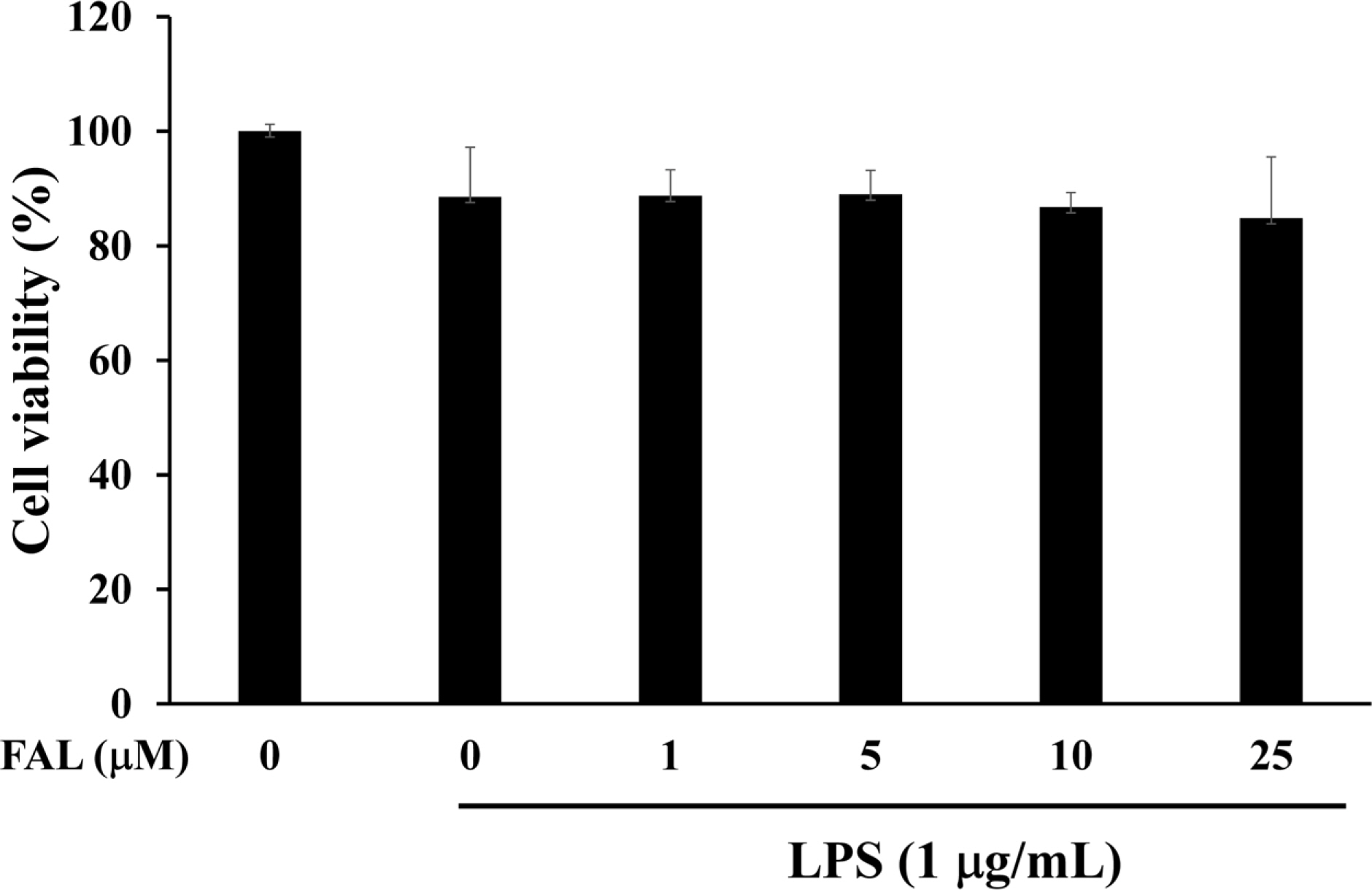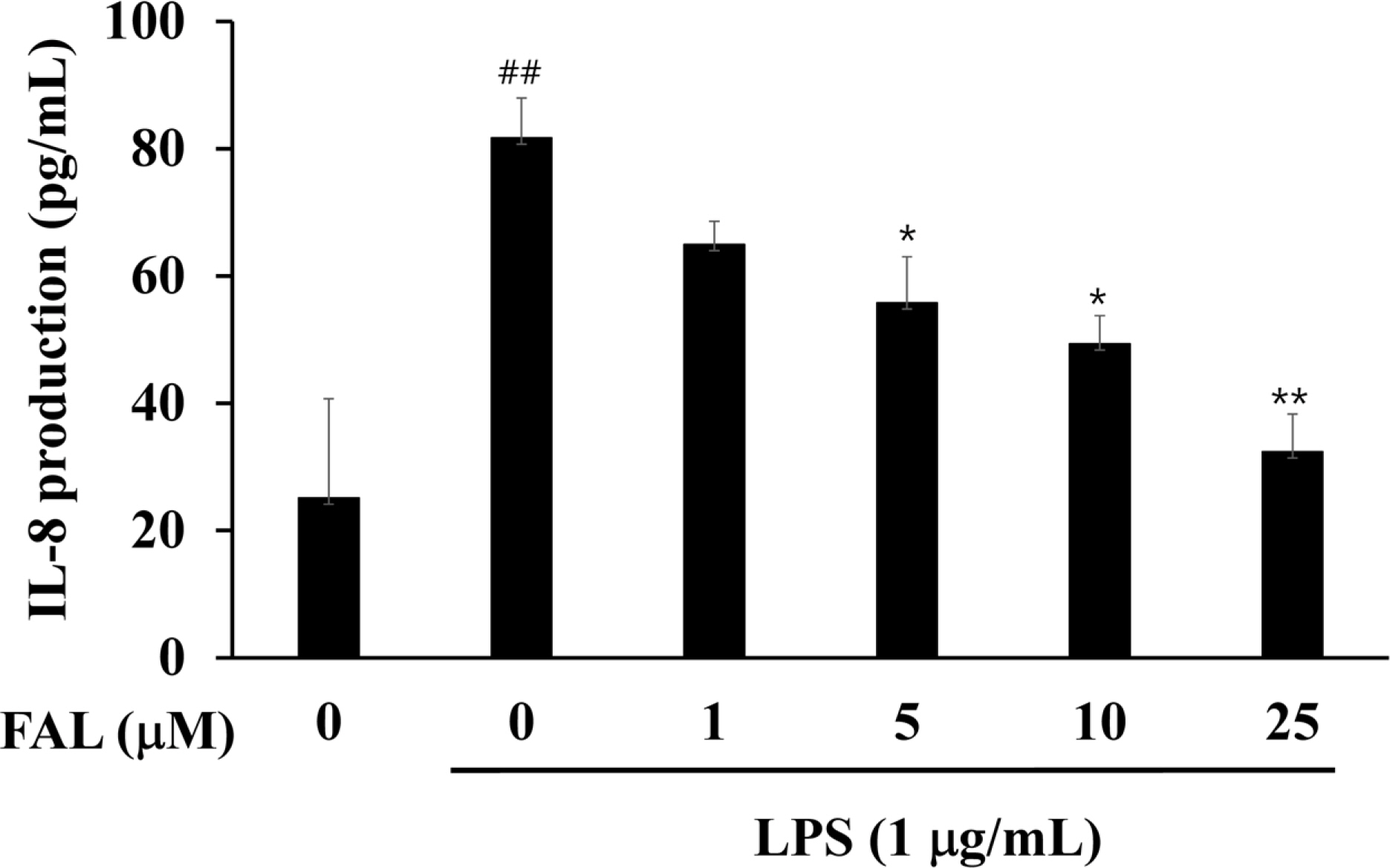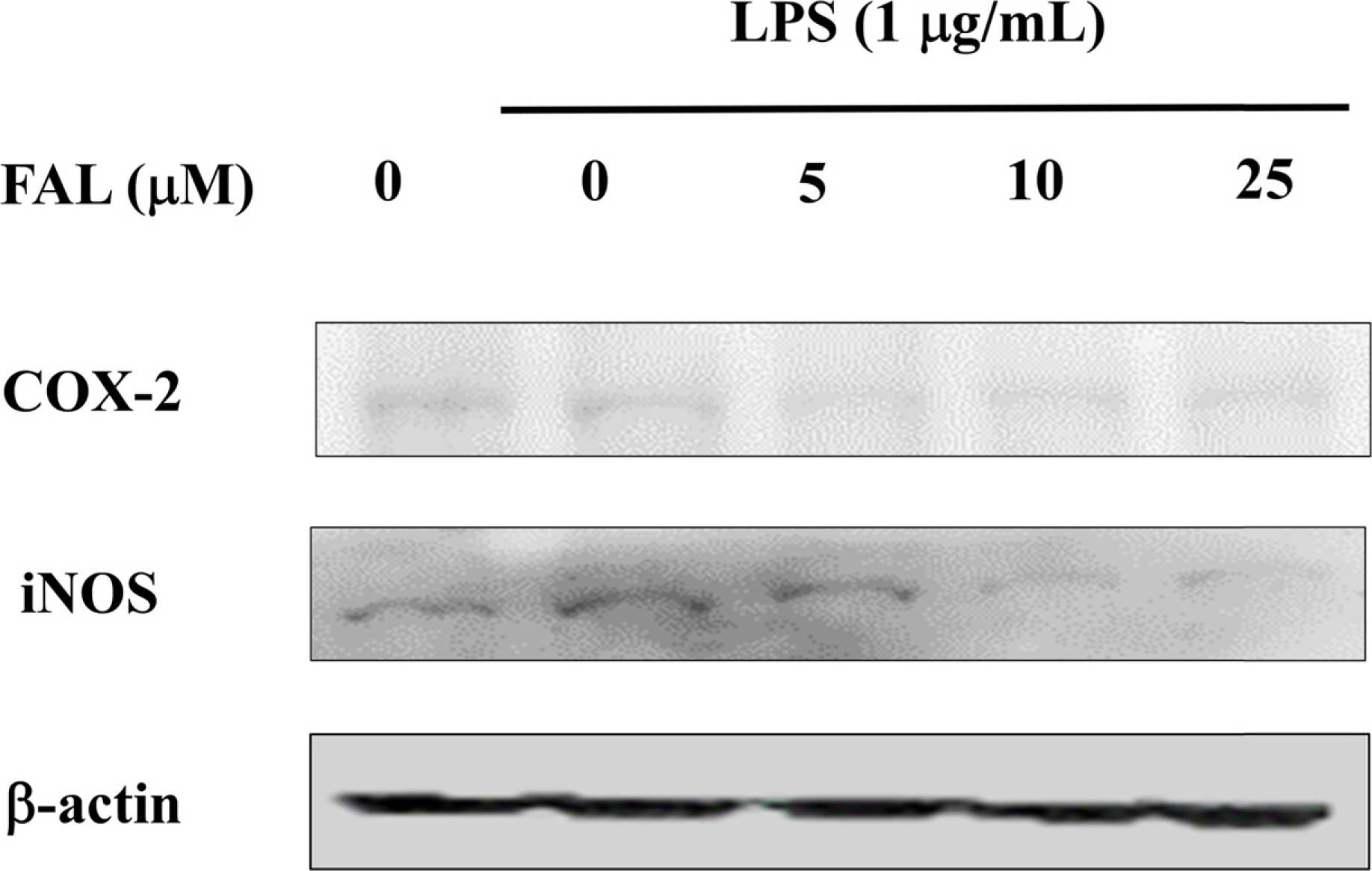Nat Prod Sci.
2017 Jun;23(2):103-107. 10.20307/nps.2017.23.2.103.
Falcarindiol from Angelica koreana Down-regulated IL-8 and Up-regulated IL-10 in Colon Epithelial Cells
- Affiliations
-
- 1College of Pharmacy, Sunchon National University, Suncheon 57922, Jeonnam, Republic of Korea. minalee@sunchon.ac.kr
- 2Suncheon Research Center for Natural Medicines, Suncheon 57922, Jeonnam, Republic of Korea.
- 3Research Institute of Life and Pharmaceutical Sciences, Suncheon 57922, Jeonnam, Republic of Korea.
- 4College of Pharmacy, Chungbuk National University, Cheongju 28644, Republic of Korea.
- KMID: 2387059
- DOI: http://doi.org/10.20307/nps.2017.23.2.103
Abstract
- Angelica koreana is an important medicinal plant for some locals in East Asia including Korea. A few reports have shown the efficacy of its phytochemical constituents. We have isolated and purified one compound falcarindiol (FAL) from the methanolic extract of A. koreana roots. At concentrations from to 1 µM to 25 µM, the FAL isolated from the roots of A. koreana exerted no significant cytotoxicity and down-regulated LPS-stimulated pro-inflammatory cytokine IL-8 in colon epithelial cells, while up-regulating anti-inflammatory cytokine IL-10. In addition, the FAL decreased the expression of LPS-induced inducible nitric oxide synthase (iNOS) and cyclooxygenase (COX)-2 protein by Western blot analysis. Colon epithelial cells play pivotal roles in regulating the colon immune system and thus FAL is expected to be candidate agent as therapeutic potential for the treatment of inflammatory bowel disease (IBD) by modulating LPS-induced inflammation in colon epithelial cells.
MeSH Terms
-
Angelica*
Blotting, Western
Colon*
Epithelial Cells*
Far East
Immune System
Inflammation
Inflammatory Bowel Diseases
Interleukin-10*
Interleukin-8*
Korea
Methanol
Nitric Oxide Synthase Type II
Plants, Medicinal
Prostaglandin-Endoperoxide Synthases
Interleukin-10
Interleukin-8
Methanol
Nitric Oxide Synthase Type II
Prostaglandin-Endoperoxide Synthases
Figure
Reference
-
References
(1). Dinarello C. A.Chest. 1997. 112:,. 321S–329S.(2). Mariani F.., Sena P.., Roncucci L.World J. Gastroenterol. 2014. 20:9716–9731.(3). Kang S. S.., Noh S. Y.., Park O. J.., Yun C. H.., Han S. H.Cytokine. 2015. 75:174–180.(4). Bogdan C.., Paik J.., Vodovotz Y.., Nathan C. J.Biol. Chem. 1992. 267:23301–23308.(5). Kang K. H.., Kong C. S.., Seo Y.., Kim M. M.., Kim S. K.Food Chem. Toxicol. 2009. 47:2129–2134.(6). Sarker S. D.., Nahar L.Curr. Med. Chem. 2004. 11:1479–1500.(7). Kim H. S.., Lee Y. J.., Lee H. K.., Kim J. S.., Park Y.., Kang J. S.., Hwang B. Y.., Hong J. T.., Kim Y.., Han S. B.Food Chem. Toxicol. 2013. 59:26–33.(8). Lee J. W.., Yun C. Y.., Roh E.., Lee C.., Jin Q.., Bang K. K.., Jung S. H.., Lee D.., Lee M.K.; Kim, Y.; Hwang, B.Y. Bioorg. Med. Chem. Lett. 2012. 22:2927–2931.(9). Seo E. K.., Kim K. H.., Kim M. K.., Cho M. H.., Choi E. W.., Kim K. N.., Mar W.Planta Med. 2002. 68:162–163.(10). Oh M. S.., Yang J. Y.., Lee H. S. J.Agric. Food Chem. 2012. 60:3606–3611.(11). Yoshikawa M.., Nishida N.., Ninomiya K.., Ohgushi T.., Kubo M.., Morikawa T.., Matsuda H.Bioorg. Med. Chem. 2006. 14:456–463.(12). Metzger B. T.., Barnes D. M.., Reed J. D. J.Agric. Food Chem. 2008. 56:3554–3560.(13). Daig R.., Andus T.., Aschenbrenner E.., Falk W.., Schölmerich J.., Gross V.Gut. 1996. 38:216–222.(14). Subramanian S.., Rhodes J. M.., Hart C. A.., Tam B.., Roberts C. L.., Smith S. L.., Corkill J. L.., Winstanley C.., Virji M.., Campbell B. J.Inflamm. Bowel Dis. 2008. 14:162–175.
Article(15). Kim J.., Kim J. S.., Park E.Food Chem. Toxicol. 2013. 62:199–204.(16). Kankuri E.., Asmawi M. Z.., Korpela R.., Vapaatalo H.., Moilanen E.Inflammation. 1999. 23:141–152.
Article(17). Takahashi A.., Yamamoto N.., Murakami A.Life Sci. 2011. 89:337–342.(18). Zschocke S.., Lehner M.., Bauer R.Planta Med. 1997. 63:203–206.(19). Deng S.., Wang Y.., Inui T.., Chen S. N.., Farnsworth N. R.., Cho S.., Franzblau S. G.., Pauli G. F.Phytother. Res. 2008. 22:878–882.(20). Sun S.., Du G. J.., Qi L. W.., Williams S.., Wang C. Z.., Yuan C. S. J.Ethnopharmacol. 2010. 132:280–285.(21). Lee S. K.., Kim T. I.., Kim Y. K.., Choi C. H.., Yang K. M.., Chae B.., Kim W. H.Biochem. Biophys. Res. Commun. 2005. 337:457–463.(22). Han Y.., Ma T. M.., Lu M. L.., Ren L.., Ma X. D.., Bai Z. H.World J. Gastroenterol. 2014. 20:11297–11304.(23). Nahidi L.., Leach S. T.., Mitchell H. M.., Kaakoush N. O.., Lemberg D. A.., Munday J. S.., Huinao K.., Day A. S.Biomed. Res. Int. 2013. 2013:909613.(24). Mitsui S.., Torii K.., Fukui H.., Tsujimura K.., Maeda A.., Nose M.., Nagatsu A.., Mizukami H.., Morita A. J.Pharmacol. Exp. Ther. 2010. 333:954–960.(25). Jeong J. B.., Shin Y. K.., Lee S. H.Food Chem. Toxicol. 2013. 55:229–233.
- Full Text Links
- Actions
-
Cited
- CITED
-
- Close
- Share
- Similar articles
-
- IL-12 and IL-23 Production in Toxoplasma gondii- or LPS-Treated Jurkat T Cells via PI3K and MAPK Signaling Pathways
- The Role of Mitogen-activated Protein Kinase in Enteritis Induced by Bacteroides fragilis Enterotoxin
- Expression of IL-17A during Thymus Regeneration in the Rat
- Interleukin-8 gene expression in the human colon epithelial cell line, HT-29, exposed to Entamoeba histolytica
- IL-18Ralpha Mediated GATA-3 Induction by Th2 Cells: IL-12 Supports IL-18Ralpha Expression in Th2 Cells






